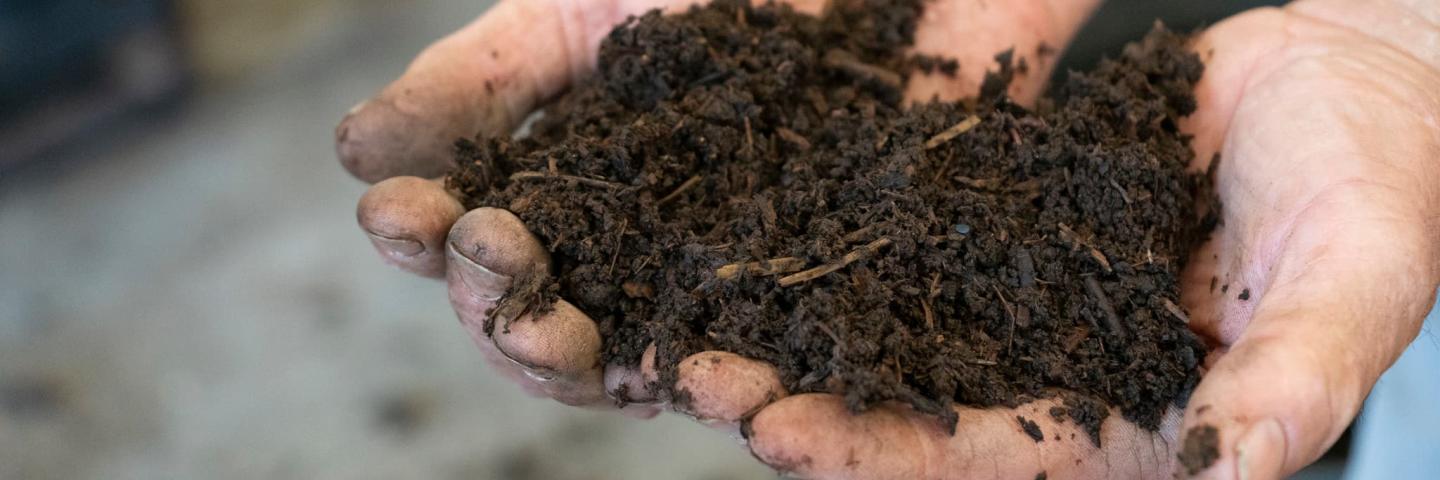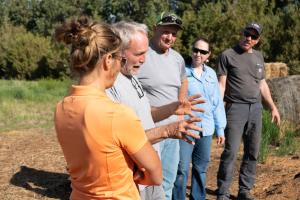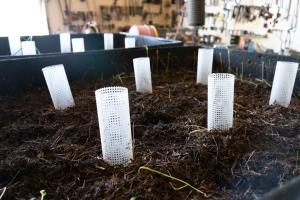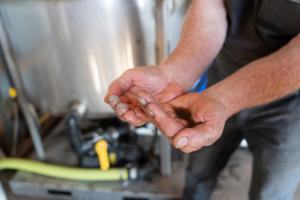Giving Back to the Soil

Farmers in Hill County, Montana, have been experimenting with composting in an effort to find new and better ways to feed their crops. Working with agencies such as NRCS has allowed the farmers to work, experiment, and learn together while sharing the rewards of their innovations with others.
“There’s always gotta be another way, not just the same as everybody else,” farmer Shawn Preputin’s grandfather used to say.
“I still have that thought process,” Preputin says. “Just because everyone else is doing it doesn’t mean it’s the right thing to do.”
Watch their story on YouTube: Conservation for the Future: Improving Soil Health through Compost, Hill County, MT
For Preputin and his neighbors and fellow farmers, Larry Johnson and Alec McIntosh, finding a new and better way to feed their crops has led them to experiment with composting. Those experiments are already showing great promise in the health of both their crops and the land.
“I was extremely happy and surprised,” says McIntosh. “We’ve been in a drought until 10 days ago, and I just thought those roots would just be struggling horribly.” When they examined the root system of some of the crops that had been treated and compared them with those that had not, they saw an appreciable difference.
“You could actually physically see a fair amount of more root mass, more soil clinging to that root mass. I was very pleased.”
Everything Starts with Soil
For all three producers, learning about composting started with a passion for soil health and a drive to see how they could improve their own crop health and production.
“Getting an interest in soil health was pretty easy in those days,” says Johnson, who started farming earlier than he intended after his father’s passing, while he was still in high school. “Every spring our whole county was just horrid. You couldn’t see for days. The ends of the fields in particular would blow every single year. When you care for the earth, it makes you sick to your stomach.”
The challenges of working the land in this dry climate can weigh on anyone. McIntosh says the burnout he was feeling with farming led him to a meeting on soil health. That meeting changed the trajectory of his work.
“I remember the speaker vividly. He asked, ‘in a teaspoon of soil, how many living organisms are in this?’ And everybody guessed and he said, ‘13 billion—more than there are people on the face of the earth.’ That got me intrigued and I’ve just been trying to understand soil health and biology,” McIntosh recalls. “It’s just been an amazing ride.”
“I probably would have got to this point at some point, but they have got me there way quicker,” says Shawn Preputin, speaking of his own interest in soil health and the way his collaboration with Johnson and McIntosh has accelerated the progress of all three producers. “I would have been ten years down this road before I would have got to this point.”
Preputin, Johnson, and McIntosh have all benefited from being able to work, experiment, and learn together, and they’re not the only ones. Outside agencies and fellow producers are also reaping the rewards of their innovations.
Teaching the Teachers

Preputin, Johnson, and McIntosh have all had positive experiences with the Natural Resources Conservation Service (NRCS) in the past, so when they made the leap into producing their own compost, it was natural for them to reach out to the team at their local NRCS office. However, the conversations they’ve had with the NRCS team reflects just how innovative and new these composting practices are.
“We’re all kind of teaching each other some things,” says Kailee Calnan, NRCS Supervisory District Conservationist for the Havre office. “They’ve just been really good about coming in and telling us about things that they’ve learned and just having conversations that is totally aside from their contracts. That’s been really helpful for me as an employee to learn things and if we learn stuff we talk to them.”
That commitment to mutual education and bettering the practices of any producer willing to listen has also impressed Marni Thompson the NRCS State Soil Health Specialist covering Montana. Speaking of Larry and Alec, she says she originally met them when the two began attending NRCS soil health workshops. “They were the faithful that came every year.” Marni and the farmers began putting their heads together.
“We started talking and then they asked me to come up and form a group that would meet in the winter at the office,” says Thompson. “We would just talk about soil health practices and what worked for them, and they would bring in young farmers like Shawn. We would sit around and have a conversation about soil health.”
The trio’s connections with Calnan and Thompson mean they have experts they can turn to when they have questions or need assistance beyond their normal means. Those connections also mean they have more partners with whom to share the ups and downs of an involved testing and experimentation process.
Testing and Experimentation

The help Preputin, Johnson, and McIntosh have received from NRCS comes primarily in the form of technical assistance as they evaluate and fine-tune their composting system.
Case in point, the three have made modifications to the Johnson-Su bioreactor they use to develop their compost in bulk. A typical bioreactor features a handful of plastic pipes extending from the base of the reactor bin to above the surface of the compost. Those pipes have holes drilled into their sides to aerate the compost, but those holes weren’t working out for the trio’s compost, so they removed the pipes, leaving needed air passages in the compost.
“As time went on, that area would dry out around that [tube’s] opening,” says McIntosh. “We figured around 15%, between that and the perimeter of the reactors, we couldn’t use. We went to plastic tubes that Shawn found on the internet that are perforated, and we leave them in, place a drip tube around the perimeter about halfway down through the compost, and add a skirt around the outside to reduce the drying effect. These changes have reduced our waste drastically.” With how much time and work goes into this process, the elimination of waste is a must.
“Initially, when we first did this, it was super labor intensive,” says Preputin. “To make a 1,500-pound batch of compost was taking probably five to six hours.” Since they were working on their composting methods in the off-season, the heavy time investment did not put Preputin, Johnson, and McIntosh off at first. But they knew to make it work for operations, they needed to refine their methods.
“We’re pre-mixing all our stuff,” Preputin points out. “Then once we get it in here, the whole process goes so much faster. The last compost that we made, we made almost 6,000 pounds in four hours.”
The three have tinkered with their methods, but their materials are geographically limited in how much they can vary. Johnson explains that the climate plays a huge role in the properties of the compost, so components from one climate won’t function the same as components from the local environment.
“Our components haven’t changed very much,” says Johnson. “How we put them together, weigh them out, and get the right mix and the right density of the product, that has changed a lot, we’ve learned a lot about that.”
Johnson believes the three will continue to try new methods and tweaks. “You’re always learning better ways,” he says.
While many people picture compost as something that comes in a bag and gets spread among crops, Preputin, Johnson, and McIntosh are finding an exciting new way to increase the area they can feed with compost while reducing the costs and materials needed to cover that area.

After letting their compost mixture develop for anywhere between nine months and a year, the three then sift that compost and put it in an extractor to transform it into a usable liquid that they can add to the seed or load onto a sprayer, drill, or other tool to put directly on their crops.
“With the compost extract, it’s adding some of that biology to the system,” says Thompson, speaking of the bacteria, fungi, and protozoa found in healthy soil. “It’s putting it down right by the seed, so the biology takes nutrients and sugars from the plant, and the biology gives the plant nutrients. Putting that biology right next to the seed enables that reaction to happen faster.”
The benefits of the trio’s experiments are not isolated to streamlined composting methods: they can be measured in the field.
“One of the main tests we did out in the field today was digging up a couple of the plants to examine their roots,” explains Thompson. “The young wheat plants that received the compost extract had larger root systems with more soil stuck to them, showing that interaction between the plant and the soil microbes is working.”
That microbiology may be impossible to see with the naked eye, but its presence has a major impact on crops, expenses, and the environmental repercussions brought on by synthetic fertilizers.
“We’re pretty early in this stage, but we hope that by ramping up that biology in the ground, some people say you can completely cut out synthetic fertilizer but, as far as the three of us, if we can cut it out by 30%, that’s a start,” says Preputin.
While composting is a major focus for the three, Preputin, Johnson, and McIntosh are following several steps to help ensure that their soil and, by extension, their crops are healthier. All three practice crop rotations, no-till or limited till, and intercropping. They are also big proponents of utilizing cover crops, which help retain soil moisture and protect the soil from overheating.
“We bought some land here in this last year that there’s been nothing but wheat on it since 1950,” says Johnson. “Soils were never, ever meant to work in a monoculture. By putting this diversity into the soil, we’re just trying to put back what was here before man came along and supercharge the soil with it in a natural way.”
A Bigger Commitment
This is about more than an aesthetic commitment to a natural landscape. McIntosh says their efforts are about preparing the soil for the future in this dry climate. With active soil biology ramping up root growth, crops should be hardier. They should be more effective in reaching and utilizing available moisture and nutrients in the soil, making the plants more resilient to drought.
“A healthy soil was designed to withstand glitches in the weather and buy you time. All we do farming is buy time until the next rain.”
While that may be underselling the amount of thought and labor the trio have put in, there’s no underselling the outreach and education work they’ve done with NRCS to help other producers in the area get on board with soil health measures.
“They’ve allowed us come up to their property and do tours and go look at their property and their cover crop,” says Calnan. “They’ve also come and been speakers at a couple of soil health events that we’ve put on the last couple years. They’ve been really good to contribute to the soil health outreach in Hill County.”
Preputin, Johnson, and McIntosh are dedicated to the mission of preparing producers and the soil to meet the needs of the future, both near- and far-term.
“I think eventually we’re going to see a point where people are going to start asking for and demanding higher-quality products, and you’re not gonna get that with synthetic fertilizer. You’re gonna have to do something else,” says Preputin.
In an industry conditioned to look at the quality of their produce in terms of bushels, the three farmers are making an effort to judge what they produce in terms of its quality and just how nutrient dense the final crop is, come harvest.
The innovations of Preputin, Johnson, and McIntosh require experimentation, trial and error, and an investment of their time and labor. While they aim to make this process easier and more streamlined for themselves and other producers, getting to that point is a challenge.
Perhaps Johnson says it best and sums up the spirit of these three farmers when he says, “challenges are good.”
More Information
To learn more about NRCS conservation assistance, please visit your local service center or NRCS - Montana.

